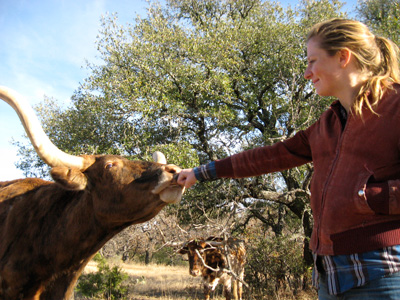 Evolution, ecology and behavior grad student Emily McTavish faces off with a Texas Longhorn. Photo by: Liz Milano.
Evolution, ecology and behavior grad student Emily McTavish faces off with a Texas Longhorn. Photo by: Liz Milano.
Prior to 1493, there were no cattle in the Americas. In fact, cows weren’t introduced until Christopher Columbus’ second voyage across the Atlantic.
Likely brought from the Canary Islands off the western coast of Africa, these early American cattle—hybrids of the Indian and European breeds—are the ancestors of the Texas Longhorns.
This may sound like the introduction to a history lesson, but it’s not. It’s science. And it’s research that has allowed Emily Jane McTavish, a doctoral candidate in UT’s Center for Computational Biology and Bioinformatics, to trace the origins of the Texas Longhorn by studying cattle genomes.
Since 2007, McTavish has been studying under UT natural sciences professor David Hillis. An evolutionary biologist and member of the National Academy of Sciences, Hillis is more than an academic: he’s a rancher. With longhorns of his own, Hillis runs the Double Helix Ranch near Fly Gap, Texas, which opened the door for McTavish’s research.
When she came to UT, McTavish wanted to work on a project with salamanders, but Hillis had a contact at the Cattlemen’s Texas Longhorn Registry who was interested in learning about the genetic history of longhorns. Intrigued, McTavish says she started the research as a summer side project. She soon realized it would take more than a few months to answer the bigger questions.
“The idea is that, like in people, if you have shared ancestry you tend to have shared variation in your genome,” McTavish says. “For example, people in Ireland, because of their shared ancestors, have certain mutations in their genome that they all share. Those mutations will be a lot less common in people from Tibet.”
McTavish says her research is fascinating because two groups of cattle, taurine and indicine, were separately domesticated from the same wild ancestor , the aurochs, a type of large wild cattle extinct since 1627.
“I am looking at genetic differences between those two independently domesticated groups,” McTavish says. “One of them is the normal cattle you’re used to seeing, and then the other group is Indian cattle, those that have floppy ears and a big hump.”
Cattle were domesticated in two major areas: the Middle East and India. From these two groups came European (taurine) cattle and Asian (indicine, those with the marked hump) cattle, Hillis says.
The cattle Columbus brought to the Americas in 1493 originated in Spain and Portugal and were taken to the Canary Islands in the 1470s. After arriving in the Caribbean, Spanish colonists fared poorly By the early 1500s, settlers no longer needed to bring the mammals across the Atlantic. In a tropical paradise with more than enough to eat, the cattle successfully reproduced. These cattle were introduced into Mexico in 1521, where they were often left to roam freely, eventually north into what is now Texas.
“That part is mostly historical—what was known,” McTavish says. “What I’ve found out using my genetic studies is that people thought that longhorn cattle were part of a European group called taurine cattle. But actually, they are hybrids between the Indian floppy eared cattle and the European cattle.”
According to her research, McTavish says about 15-20 percent of the Texas Longhorn genome is from the Indian ancestors, who were more drought-tolerant and survived better without much food than their European counterparts. This may be what makes longhorns fare so well in Texas’ hot summer temperatures.
“I really like that Longhorns, a lot like the rest of the country, are this international hybrid,” McTavish says. “It fi ts into the American story in a way that I think is really cool.”
To study the DNA sequence data of the cattle, ranchers take blood samples and mail them to GeneSeek, a lab in Nebraska, which then sends the data to McTavish. Other data come from the lab of a genetics professor at University of Missouri.
“What you would think of as the typical science part, with test tubes, I don’t do any of,” McTavish says. “All of my research now happens on my computer.”
Thanks to her research, McTavish has earned some Texas street cred.
“Everyone thinks it’s neat that I’m at UT and studying longhorns,” McTavish says. “I’m from New York, and I’m not Texan at all. It makes me feel like I’ve sort of incorporated myself into UT.”
So what about Bevo specifically?
“People tell me that I need to sequence Bevo, but I haven’t done it yet,” McTavish says. “If his veterinarians sent me a blood sample, I could include Bevo in my research.”
— Katy McDowall
This article originally appeared in The Alcalde.


















Comments 1
this is a great article. very interesting and informative. i love features like this.